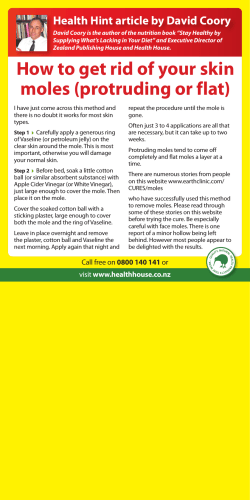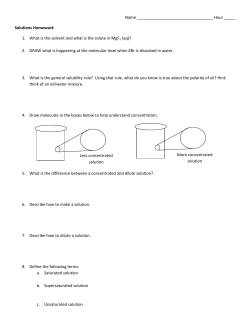
Stoichiometry Chemistry Karl Steffin © 2007
Stoichiometry Chemistry Karl Steffin © 2007 7/19/2014 Stoichiometry • Unit changes: Three Molar truths. • Relationships between product and reactant set up new truths. • Being able to determine the amounts and study the quantitative relationships of equations is called stoichiometry. • The most important idea in this chapter is to look at the coefficients of the formula. N2H4 + 2H2O2 N2 + 4H2O Using Coefficients N2H4 + 2H2O2 N2 + 4H2O • This reaction needs the following: – 1 mole of N2H4 and 2 moles of H2O2 – To produce… – 1 mole of N2 and 4 moles of H2O • How many moles of H2O are produced if you have 3.55 moles of N2H4? (assume you have enough Hydrogen Peroxide) Same as it ever was N2H4 + 2H2O2 N2 + 4H2O • Use the same ideas from before: – – – – Circle what you have and what you want… Write what you know… What you have on bottom (including the coefficient). What you want on top (including the coefficient). 4 moles H2O 3.55 moles N2H4 x 1 mole N2H4 14.2 moles H2O Upping the Ante • The last problem was a mole to mole problem. • If given grams, Liters (of gas) or units, it is still possible to solve with one new thought – After Writing what you know… – Ask ‘Is it in moles?’… if no, convert to moles. Big Idea • Here is a flow chart that may help. Quantity of Unknown Quantity of Given Use matrix to convert to moles Use matrix to convert to unit Use molar ratio Moles of Given Moles of Unknown Thermite Reaction • In a Thermite reaction Aluminum powder reacts with Iron (III) Oxide to form Aluminum Oxide and Molten Iron… If in a complete reaction 2.3-g of Aluminum are needed, how many grams of Aluminum Oxide are produced? • Write what you know (and circle). 2Al + Fe2O3 Al2O3 + 2Fe 2.3-g ?-g Thermite Reaction 2.3-g ?-g 2Al + Fe2O3 Al2O3 + 2Fe • Convert Grams to Moles… 2.3-g Al x 1 mole Al = .0851 moles Al 27.0-g Al • Use Molar Ratio… 1 mole Al2O3 .0851 moles Al x = .04 moles Al2O3 2 moles Al • Convert Back to Grams… 102.0-g Al2O3 = 4.4-g Al2O3 .04 moles Al2O3 x 1 mole Fe2O3 1 mole Al2O3 Limiting Reactants • There are two ways to mix chemicals together. – Measure exactly how much of each chemical is needed to produce a reaction. – Put random amounts of each chemical together and see how much is produced. • In the second case one of the chemicals will be a limiting reactant. • Think about this… A Table requires four legs and one top. If you had 22 legs and 6 tops how many tables could you make? What part is limiting the production? 4Lg + 1 Tp 1Tb Visual Approach x6 6 Tops = 6 Tables x6 22 Legs = 5.5 Tables x5 x 22 The Legs limit the construction of more tables. Solving Limiting Reactants • Write what you know – If not given the balanced formula – Circle both given amounts • Find out how much product each reactant will produce. (double the work) – If not told specifically solve for any one product. • The one that produces the least amount is the limiting reactant. Limiting Reactant Example • What is the limiting reactant when 1.7-g of Sodium and 2.6-L of Chlorine gas at STP produce Table Salt? 2Na + Cl2 2NaCl 1.7-g 2.6-L ?-g 2 NaCl 58.5-g 1-mol 1.7-g Na x x x 2 Na 1-mol 23.0-g 1.7-g Na4.3-g NaCl 1-mol 2 NaCl 58.5-g 2.6-L Cl2 x x x 1 Cl2 1-mol 22.4-L 2.6-L Cl213.0-g NaCl Percent Yield • Despite best plans in any reaction the amount of products expected, is more than what is actually produced. • It can be useful to calculate the efficiency of the formula. (much like % error in a lab). Actual Yield Percent Yield = x 100 Expected Yield Percent Yield Example • A piece of Copper (5.0-g) is placed in a solution of excess Silver Nitrate. When separated 7.2-g of Silver is produced. What is the Percent Yield? Cu + AgNO3 Ag + CuNO3 5.0-g ?-g 1 Ag 107.9-g 1-mol 5.0-g Cu x x x 63.5-g 1 Cu 1-mol 5.0-g Cu should produce 8.5-g Ag Percent Yield Example • So in the reaction the 5.0 grams of Copper should have yielded 8.5-g of Silver but the problem stated only 7.2-g was produced. 7.2-g Ag x 100 = 84.7% 8.5-g Ag • Note the Percent Yield can never be more than 100%.
© Copyright 2025













